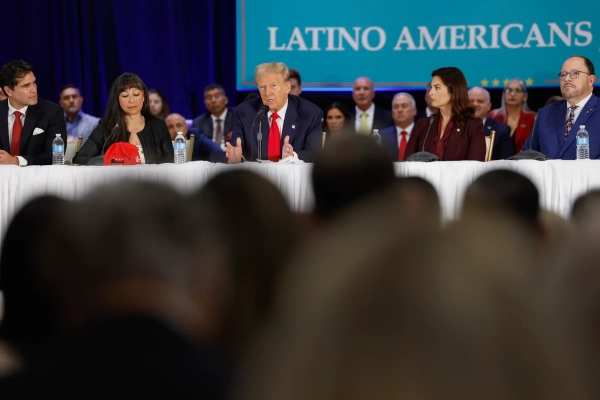“`html 
Customs duties. Raids conducted by the United States Immigration and Customs Enforcement. Deployments of the National Guard. The Epstein Files. Attacks directed at Iran. Gaza alongside Ukraine. Unyielding inflation. The initial year of President Donald Trump’s second term has resembled a deluge of unpopular policies, belligerent strategies, and recurrent conflicts alongside those he views as foes.
Each of these occurrences has generally prompted an equivalent inquiry: Will any of these issues resonate with the electorate who formed his victorious alliance in 2024? Will he suffer a decline in backing, disrupt his coalition, and spell doom for future Republicans? Or was the year 2024 a more enduring shift in the landscape of American politics?
The response is not as clear as headlines often depict. There has been some erosion of backing within Trump’s 2024 voting bloc, but it does not constitute the GOP cataclysm that certain headlines have tended to suggest (for instance, claiming the alliance has “disintegrated”).
Comparable assertions arose after Trump declared his Liberation Day tariffs, subsequent to American offensives against Iran, following the Epstein Files dominating media attention, and as Trump commenced enforcing his immigration regulations and executing deportations. However, in spite of everything, throughout this summer and heading into autumn, his favorability and approval scores have remained consistent — unfavorable, historically diminished, yet not a complete implosion.
Thus, what can we deduce concerning the condition of Trump’s 2024 alliance? At minimum, three points:
- He’s forfeiting the greatest degree of backing among demographics that provided him with the largest enhancements in 2024, notably including Hispanic/Latino individuals and young adults.
- A vast majority of Republicans and conservatives continue to favor what they are observing from Trump.
- Opinions of the financial system, by far, remain the primary hazard to this unsteady association. Furthermore, there are no unmistakable signals that sentiments are evolving in Trump’s favor.
Establishing Context: Trump’s Bloc Largely Remains Supportive
It’s vital to define what we signify when referencing Trump’s bloc. It encompasses the devoted MAGA base: predominantly composed of white, rural, and non-college educated people. And it encompasses a considerable range of novel voters who furnished him with the margins needed to narrowly secure the popular vote and key battleground states: youth and voters of color, notably including young men, and former Democrats who felt disgruntled with the establishment and existing circumstances. These more recent Trump voters were not rigidly conservative or steadfast Republicans, but they were unengaged, discontented, and yearned for alteration.
Nearly a year later, the bulk of this bloc still endorses Trump. The most recent New York Times/Siena College survey, among the most valuable tools at our disposal, reveals minimal shifts in individuals’ sentiments concerning the president presently in contrast with four months prior. Between April and September, Trump’s proportion of support has held firm at approximately 42 to 43 percent.
In other words, around 40 percent of the nation sanctions Trump’s presidency across every controversy and declaration, while a slight majority routinely disapproves. That supportive minority contains upwards of nine out of 10 Republicans, somewhat less than one-third of Hispanic voters, and approximately half of voters older than 45.
Yet, Manifestations of Attrition Exist, if Not Entire Dissolution
Nevertheless, the information accessible to us indicates that circumstances are not entirely positive. By examining both presidential approval scores, broad congressional ballot polling, and economic sentiment, a definitive depiction materializes showcasing diminished backing among younger demographics and Latino voters stemming from unfavorable economic conditions.
“He has ceded more territory among the individuals who provided him with the greatest gains in the preceding year — young individuals and Hispanics,” Elliott Morris, a data journalist overseeing the Strength in Numbers publication, conveyed to me. Based on Morris’s assessments, there has been approximately a 30 percentage point variance in approval among these voters moving away from Trump in comparison to his margins of victory — implying that a transformation is occurring among this segment of the electorate.
The NYT/Siena poll captures a portion of this as well. Trump’s backing among youth is startlingly deficient. A mere 30 percent endorse him, relative to the 66 percent who disapprove. His backing among Latinos is analogous: Only 26 percent endorse him, whereas 69 percent disapprove. These figures stand in sharp contrast to Trump’s 2024 outcomes, when he almost outright won over both young and Latino voters the previous year.
Evaluating broad congressional ballot polling additionally reveals a migration of these voters away from Republicans toward Democrats, according to Lakshya Jain, the director of political data at The Argument. “In what areas are Democrats presently gaining the most with voters in contrast with their standing in 2024? The recurring observation is [gains] among young voters [and] Hispanics,” Jain stated.
Morris approximates this broad ballot migration among both cohorts at approximately 10 points diverted from Republicans — not as pronounced as the approval statistics, yet nonetheless substantial.
Additionally, the underpinnings for this diminishment, as articulated by both Morris and Jain, are largely linked to economic considerations and factors related to incumbency. These voters who gravitated toward Trump in 2024 exhibited heightened sensitivity to economic circumstances — encompassing inflation, escalating prices, and affordability — and sustain a pessimistic perception of the economy currently.
“It centers on the economy. Views are unfavorable, individuals are discontent, and individuals believe Trump is not concentrating primarily on economic matters,” Jain remarked.
In 2024, Trump benefited from holding an external position; dissatisfied voters possessed the avenue of rejecting the established order by casting their ballots for him. In the present year, Morris conveyed to me, they are devoid of that avenue. Their discontentment is manifesting as disapproval of Trump.
“A substantial portion of these voters did not endorse Donald Trump owing to his identity as Donald Trump, but rather as a result of the economy,” Morris elucidated. “This evident repositioning of these demographics away from Trump bears diminished resemblance to a political proclamation concerning Trump and more closely resembles a response to fundamental economic dynamics. In essence, they are neither decidedly pro-Trump nor vehemently anti-Trump — rather, they are opposed to the established order.”
This constitutes the more protracted hazard for the GOP. A multitude of voters within the Trump bloc harbored adequate discontent to vote against the Democratic incumbents of 2024 — yet in the event that they sustain their dissatisfaction, Republicans might prove unable to rely on them come 2026.
Correction, October 7, 5:45 pm ET: This story initially misstated the most recent youth approval rate for President Donald Trump; it was at 30 percent in a September NYT/Siena poll.
“`
Source: vox.com






